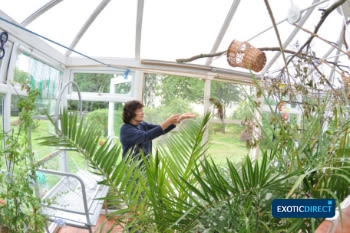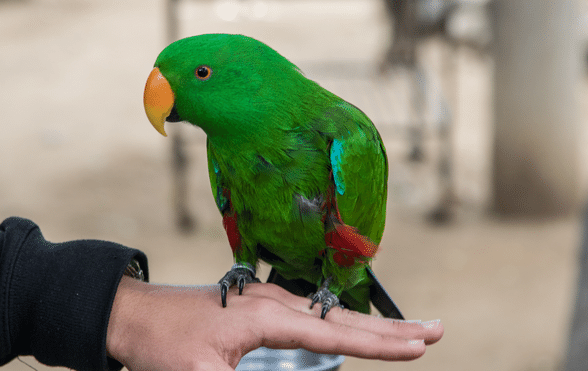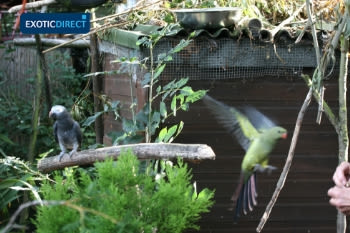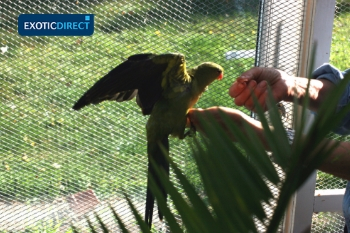Find out how to teach your bird fly to you, and the techniques you should be using.
Is your parrot insured? Get a quote for up to £5,000 of vet fee cover, death and theft cover | We’ve been insuring exotic pets since 1996 | Check out our customer reviews on Feefo.
Recall and step up are the foundations of a happy, safe relationship with your companion parrot. How to train Step Up was described on this site in 2016.
How does one teach the recall? The same sequence of events won’t suit every single bird.
You may have a young one, a newly acquired pet or a rescue or rehome bird who may have developed problem behaviour.
The basic theory, that you should train using positive reinforcement with the minimum of negative reinforcement holds true for every bird.
The devil is in the details. You have to adapt training to suit both your schedule and the bird’s capabilities and personality.
Table of contents: Unweaned chicks | Teaching recall to a fledged young bird | Teaching recall to a new bird |Recall exercises | Avoiding latency | Teaching Rescue, Re-homed and Traumatised birds | How can you recall an escaped parrot? | Which is the best parrot to teach to fly and recall?
Unweaned chicks
For a hand fed bird, who’s been carefully weaned, teaching recall is a doddle. During the early days, the baby is on the feeder’s lap or on a table.
Once it is standing up alone, the handler offers the spoon or syringe and the baby accepts. The handler simply needs to hold the spoon a few centimetres away and the baby moves toward it.
If the bird is being clicker trained the clicker is used. I use the word ‘good’. After a few feeds, the chick will march confidently towards whoever holds the syringe or the spoon.
This is also a good time to develop trust and affection. Just as the parent birds are responsive to chicks in the nest so you can respond to your baby bird with affectionate words and touch.
Remember, conscientious breeders do not sell un-weaned birds to inexperienced carers. It is sound advice for a new owner not to attempt hand feeding or complete weaning.
It’s possible to complete the weaning if the baby is down to two hand feeds a day and if the breeder or a knowledgeable friend gives you the proper instructions.

Teaching recall to a fledged young bird
The next stage is fledging. At this stage, in the wild, they leave the nest and feed themselves.
The easiest bird to start training is a young fledgling that has never been clipped and been allowed to learn how to fly down from a height, as well as hover, turn and stop.
Wild birds learn this in nature. Our homes often usually don’t have enough height for the bird to practise. Stair wells can be useful.
I live in a bungalow, so I took the Greys to the school hall where I was teaching.
The macaws learned how to fly down without fear by practising in a friendly neighbour’s barn.
To teach the bird to come to you, you ask the young bird to step out of his cage. Or if he is loose in a room, onto your hand. These are the basic principles of step up, teaching the bird to step up to you.
Place him on a steady perch and stand near enough to give him a treat, then move away a few centimetres, so the bird has to stretch forward. Then move a little further so he has to hop onto your hand.
Once that behaviour is confirmed, it follows easily that the young bird will flap a few paces to your hand. He then gets clicked immediately or you use your positive word “good bird’ or whatever and give the treat.
It shouldn’t take more than a few days before a young bird will answer the contact call. Mine is ‘fly to me’ plus my attempt at an African Greys’ wheep.
You can give recall lessons before feeding breakfast or giving the afternoon feed.
It is easier to train young birds or any birds if they do not have food bowls filled all day long. If food bowls are left filled, a bird often nibbles a morsel and when you want some response from them, they are not hungry.
A couple of anecdotes
| A friend, an experienced carer, keeps several indoor birds. Maisie, the Grey, like all Carol’s birds, is flighted and has been taught basic behaviours.
One December evening, some years ago, while answering the door bell, Carol forgot Maisie was on her shoulder. Maisie darted across the New York street to the top of one of the few city trees. It was pitch dark and freezing. Carol knows birds don’t fly in the dark. Her solution was ingenious. With torches and borrowed flashlights, she lit up the bare branches. Maisie flew down to her after a few contact calls. We never expect our birds to get out, but accidents do happen. The bird usually won’t go far. Without a trained recall and practice in flying down, it can be extremely difficult to retrieve your pet even though you know where he is. And sadly, sometimes the bird is lost forever. Another friend living in Essex used to take her clipped, wild caught Timneh outside for walks (NOT recommended) She had had it for 20 years. A gust of wind caught the parrot and whirled it to the top of a pine tree. They called her in vain from below. Next morning the Timneh had vanished – never to be seen again. Yes, these are isolated, rare instances but similar ones happen. A window was left open in my bird room and Casper Grey, aged one, flew out. I rushed into the garden; a flock of pigeons were flying off, one with a red tail. ‘Casper,’ I screamed and gave our contact whistle. The flock was about 100 metres away. The red-tailed pigeon made a semi-circle and landed on the bungalow roof. With my heart thumping, I fetched the step ladder, leant across the gutter and asked ‘Step up’ as enticingly as I could. Casper waddled over the roof tiles and back into my arms. |
Teaching recall to a new bird
When teaching recall to the newly acquired bird, you can use the same procedure that the hand feeder uses – encouraging the bird to come towards you for a treat.
If not already known, you should then teach it step up, with recall usually the next behaviour taught. You bird will need to fully trust you in order to be able to train for step up and recall.
In the case of the handfed baby, it trusts people already, so should a young bird that you’ve acquired from a reputable source.
Recall exercises
Once the student is flying a few metes reliably to your hand in a room, you can add all sorts of exercises and games. Hiding in another room and calling the bird to you. Flying between one person and another. Once your bird responds to your contact call and/or whistle you can play Hide and Seek.
Avoiding latency
It is important that a bird responds immediately (within a few seconds) to your call. If you persist in repeating the call and the bird only responds after several minutes, then you are inadvertently teaching latency.
The way to avoid that is – if the bird does not come to the first request – is turn your back – maybe leave the room for a few seconds. If your timing is right, the bird is eager for the treat (whether it’s a favourite food, a desired toy or a head scratch) so she soon realises that non-compliance means no reward.
Teaching rescue, re-homed or traumatised birds
It is not always the ideal situation that you are in. How do you teach recall to a rescue bird, a rehomed or traumatised bird that cowers in its cage and won’t step up? And may try to bite you as well.
Such cases are not unsolvable. The bird will step up and will recall to you once it no longer fears you.
You cannot put a time limit on how long it will take you to earn the trust of a traumatised bird. From what I have learned from my own birds and those that I know about, the time scale has been from one day to two years.
Although your efforts may be discouraging at the start when training a traumatised bird, stay calm and be patient. The rewards are considerable when such a bird steps up and even more so, flies to your proffered hand.
How can you recall an escaped parrot?
The principles of recall based on positive reinforcement remain the same where ever the bird is.
If your bird escapes you can use your contact call to attract it back, and positive reinforcement once it returns. My anecdotes provide a good example of how it can be done.
Which is the best parrot to teach to fly and recall?
A lot of this depends on how the bird was socialised and weaned. In general budgies, cockatiels and conures are easier for novices.
Macaws and cockatoos are not starter birds, although some starters manage well.
Amazons and Greys adapt well to sensitive handling.
Is your parrot insured? Get a quote for up to £5,000 of vet fee cover, death and theft cover | We’ve been insuring exotic pets since 1996 | Check out our customer reviews on Feefo.



